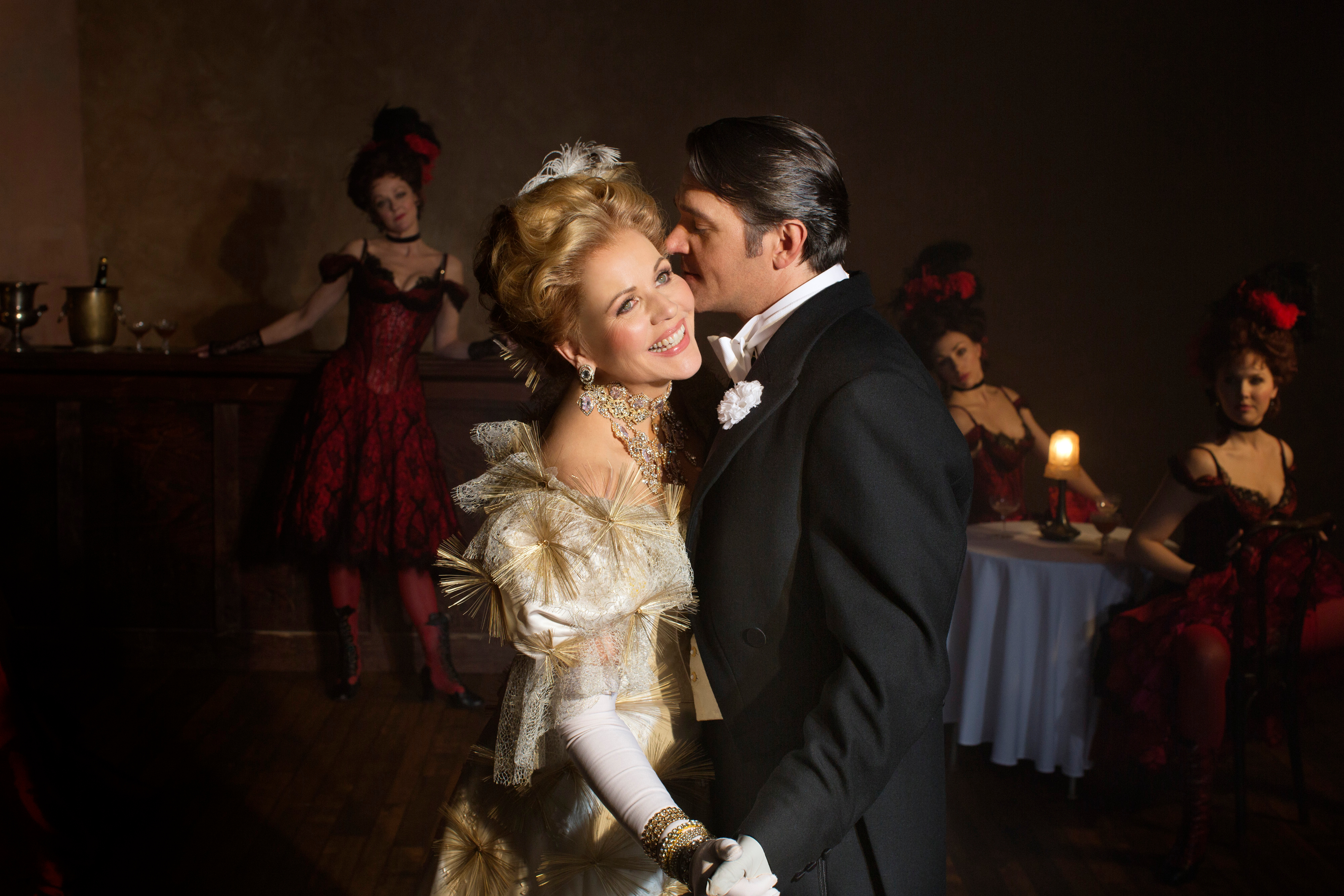
Susan Stroman’s ‘The Merry Widow’ dances the Met into the new year
Photo: Brigitte Lacombe/Metropolitan Opera
New production premiere of Metropolitan Opera’s “The Merry Widow”
By Richard Carter, Examiner.com
Rating: five stars
Wednesday, Dec. 31, 2014, the Metropolitan Opera ushered in the new year with an effervescent new production of Franz Lehár’s frothy operetta “The Merry Widow,” in every way the inspired vision of Director and Choreographer Susan Stroman, a five-time Tony award winner, in her highly anticipated Met debut. With sets by Julian Crouch and costumes by William Ivey Long, the creative team brought late nineteenth-century Paris to the footlights. A real eye-pleaser with a solid cast of singers and actors that made suspending belief a most willing surrender.
Soprano superstar Renée Fleming interpreted the title role, Hanna Glawari, for the first time anywhere. In her mid-fifties and already transitioning into artistic life after her singing career, the role fits her tailor made. Having seen her exclusively in semi-heroic and tragic operas, she was a pleasant surprise in romantic comedy, at once agile and elegant and not a bad dancer. The creamy voice is still lithe, in full bloom, with a striking trill perfectly intact. It is obvious the Act II “Vilja Song” is a personal favorite, which she dispatched beautifully.
Opposite her as Count Danilo Danilovitch, an old flame who does everything to avoid admitting rekindled feelings for the magnificently monied Hanna lest he appear self-seeking, baritone Nathan Gunn cut a dashing figure and sang with easy richness of timbre, almost a tenor in the upper range. He moved well, whether dancing or cavorting. He was a standout in the Act II male septet, and he blended well in ensembles with all cast members throughout the work.
In her Met debut, oft-Tony-nominated Kelli O’Hara made a splash in a venue that is three to four times the size of the Broadway theaters where she has built quite a distinguished career. With acting chops, a full operatic voice and the clearest diction, her lovely sounds easily reached the loftiest heights, both in tessitura and in aiming for the rafters. She credibly portrayed Valencienne’s Act III tipsiness without exaggerating and is sufficiently accomplished as a dancer to dance clumsily with the grisettes and make it look genuine. She received hearty applause during the final-act curtain calls.
Baroness Valencienne in this production is more knowing than the ingénue that usually inhabits the role of the conflicted new “respectable wife” of Baron Mirko Zeta; she does no running from former lover Camille de Rosillon, sung by sweet-voiced tenor Alek Shrader, and in fact simultaneously pushes him toward Hanna while clutching him, not wanting to let go. The tenor defended himself well in all his sumptuous melodies but had the habit of covering his voice in its highest reaches instead of taking a more full-throated approach. His colleagues completely drowned him in the exquisite Act II quintet.
As Baron Zeta, Valencienne’s unsuspecting husband and ineffective Pontevedrin ambassador in Paris, veteran British baritone Sir Thomas Allen, the only non-American among the five principals, brought elegance, honeyed tone and excellent comic timing to a role that begs for an aria or at least a duet.
Actor Carlson Elrod deserves special mention for his ditsy portrayal of Njegus, Count Danilo’s bumbling assistant, in this production a spoken role. His hilarious histrionics and impeccable comedic timing made one wish for an expanded role. The now defunct New York City Opera years ago staged a colorful production of this work in which Njegus had an hysterical aria complete with fleet footwork and pratfalls. Seeing Carlson Elrod make much of a relatively small role begs the question of what he would do with that (interpolated) aria. Perhaps it wouldn’t much matter what kind of singing voice he has.
British conductor Sir Andrew Davis led the forces of the splendid Metropolitan Opera Orchestra and the unmatched Metropolitan Opera Chorus while indulging and supporting the soloists in consistently stellar performances. Balance problems between stage and pit plagued much of Act I, rendering some singers nearly inaudible, but Maestro Davis happily resolved these for the remainder.
Dance abounds in any production of “The Merry Widow.” Susan Stroman achieved graceful movement from all cast members, whether dancers or “civilians.” In this production, the Act I curtain rises halfway through the overture to reveal numerous couples spinning and swaying to one of the countless waltzes that punctuate the sublime score. We are, after all, at a ball held at the Pontevedrin embassy in Paris where these lovable Balkan expats hope to raise money for their nearly bankrupt imaginary nation.
Act II, set at Hanna’s villa, opens with energetic folk dancing. The dance troupe returns yet again in Act III, set in Chez Maxim, this time to complement the grisettes’ lively cancan. The talented dancers accommodated the various dance styles depicted, giving “The Merry Widow” its special charm. In view of such a substantial balletic contribution, they unjustly go uncredited in the printed program. From their part alone, it is easy to see why Susan Stroman has won five Tony awards.
The Met’s new “Merry Widow” is the cure to all that ails you. It will lift your spirits, calm your anxiety and never fail to entertain. Unless your name is Martin Bernheimer, poor man.